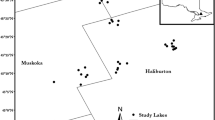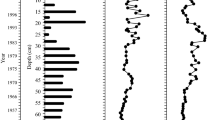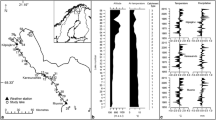Abstract
Lakes of the Andean páramo are critical water reservoirs for millions of people. Páramo ecosystems have experienced anthropogenic warming faster than the global average. Recent paleolimnological work from Cajas National Park (southern Ecuador) revealed striking shifts in diatoms and Cladocera linked to climate change. However, the impacts on shallow lakes (< 5 m deep), which are numerically dominant on the landscape, remain poorly understood. Here, we use paleolimnology to investigate cladoceran species changes and responses to climate change in three shallow waterbodies from Cajas. Each system supported abundant littoral Cladocera. The deepest site (~ 4 m) contained the highest proportion of pelagic taxa, while the shallowest (~ 0.3 m) contained almost exclusively littoral taxa. Cladoceran assemblages in these shallow lakes reflect littoral habitat, likely partly influenced by shifting precipitation, and in one site, construction of a small rock dam. The cladoceran assemblage shifts do not align with regional temperature increases and reduced wind speeds, contrasting the ecological responses previously recorded in nearby deeper lakes. Although these polymictic, ice-free shallow systems are not immune to climate-related change, algal and cladoceran assemblages in nearby deeper lakes are responding earlier and more sensitively to recent climate changes, largely through changes to lake thermal stratification regimes.





Similar content being viewed by others
References
Appleby, P. G., 2001. Chronostratigraphic techniques in recent sediments. In Last, W. M. & J. P. Smol (eds), Tracking environmental change using lake sediments, Vol. 1., Basin analysis, coring, and chronological techniques Springer, Dordrecht: 171–203.
Bos, D. G. & B. F. Cumming, 2003. Sedimentary cladoceran remains and their relationship to nutrients and other limnological variables in 53 lakes from British Columbia, Canada. Canadian Journal of Fisheries and Aquatic Sciences 60: 1177–1189.
Brecher, H. H. & L. G. Thompson, 1993. Measurement of the retreat of Qori Kalis Glacier in the tropical Andes of Peru by terrestrial photogrammetry. Photogrammetric Engineering and Remote Sensing 59: 1017–1022.
Brodersen, K. P., M. C. Whiteside & C. Lindegaard, 1998. Reconstruction of trophic state in Danish lakes using subfossil chydorid (Cladocera) assemblages. Canadian Journal of Fisheries and Aquatic Sciences 55: 1093–1103.
Buytaert, W., R. Célleri, B. De Bièvre, F. Cisneros, G. Wyseure, J. Deckers & R. Hofstede, 2006. Human impact on the hydrology of the Andean páramos. Earth-Science Reviews 79: 53–72.
Coronel, J. S., X. Aguilera, S. Decleck & L. Brendonck, 2009. Resting egg bank reveals high cladoceran species richness in high-altitude temporary peat land pools. Revista Boliviana de Ecología y Conservación Ambiental 25: 51–67.
Delachaux, T., 1918. Cladocères des Andes péruviennes. Bulletin de la Société Neuchâteloise des Sciences Naturelles 43: 18–38.
Espinosa, C., 2005. Payment for water-based environmental services: Ecuador’s experiences, lessons learned and ways forward. IUCN Water, Nature and Economics Technical Paper No. 2, IUCN, Ecosystems and Livelihoods Group Asia, Colombo, Sri Lanka.
Foster, P., 2001. The potential negative impacts of global climate change on tropical montane cloud forests. Earth-Science Reviews 55: 73–106.
Francou, B., P. Ribstein, P. Wagnon, E. Ramirez & B. Pouyaud, 2005. Glaciers of the tropical Andes: indicators of global climate variability. In Bugmann, H. K. M. & M. A. Reasoner (eds), Huber UM. Global change and mountain regions. Advances in global change research. Springer, Dodrecht: 187–204.
Giles M, N. Michelutti & J. P. Smol, 2018. Long-term limnological change in the Ecuadorian páramo: comparing the ecological responses to climate warming of shallow versus deep lakes. Freshwater Biology. https://doi.org/10.1111/fwb.13159.
Glew, J. R., 1988. A portable extruding device for close interval sectioning of unconsolidated core samples. Journal of Paleolimnology 1: 235–239.
Glew, J. R., 1989. A new trigger mechanism for sediment samplers. Journal of Paleolimnology 2: 241–243.
Hansen, B. C. S., D. T. Rodbell, G. O. Seltzer, B. León, K. R. Young & M. Abbott, 2003. Late-glacial and Holocene vegetational history from two sites in the western Cordillera of southwestern Ecuador. Palaeogeography, Palaeoclimatology, Palaeoecology 194: 79–108.
Herzog, S. K., R. Martínez, P. M. Jørgensen & H. Tiessen (eds), 2011. Climate change and biodiversity in the tropical Andes. Inter-American Institute for Global Change Research (IAI) and Scientific Committee on Problems of the Environment (SCOPE), New York.
Hofmann, W., 1998. Cladocerans and chironomids as indicators of lake level changes in north temperate lakes. Journal of Paleolimnology 19: 55–62.
Hulme, M. & D. Viner, 1998. A climate change scenario for the tropics. Climatic Change 39: 145–176.
Jeziorski, A., N. D. Yan, A. M. Paterson, A. M. DeSellas, M. A. Turner, D. S. Jeffries, B. Keller, R. C. Weeber, D. K. McNicol, M. E. Palmer, K. McIver, K. Arseneau, B. K. Ginn, B. F. Cumming & J. P. Smol, 2008. The widespread threat of calcium decline in fresh waters. Science 322: 1374–1377.
Jeziorski, A., B. Keller, A. M. Paterson, C. M. Greenaway & J. P. Smol, 2013. Aquatic ecosystem responses to rapid recovery from extreme acidification and metal contamination in lakes near Wawa, Ontario. Ecosystems 16: 209–223.
Korhola, A., 1999. Distribution patterns of Cladocera in subarctic Fennoscandian lakes and their potential in environmental reconstruction. Ecography 22: 357–373.
Korhola, A. & M. Rautio, 2001. Cladocera and other brachiopod crustaceans. In Smol, J. P., H. J. B. Birks & W. M. Last (eds), Tracking environmental change using lake sediments, Vol. 4., Zoological indicators Springer, Dordrecht: 5–41.
Korhola, A., S. Sorvari, M. Rautio, P. G. Appleby, J. A. Dearing, Y. Hu, N. Rose, A. Lami & N. G. Cameron, 2002. A multi-proxy analysis of climate impacts on the recent development of subarctic Lake Saanajärvi in Finnish Lapland. Journal of Paleolimnology 28: 59–77.
Korosi, J. B. & J. P. Smol, 2012a. An illustrated guide to the identification of cladoceran subfossils from lake sediments in northeastern North America: part 1 – the Daphniidae, Leptodoridae, Bosminidae, Polyphemidae, Holopedidae, Sididae, and Macrothricidae. Journal of Paleolimnology 48: 571–586.
Korosi, J. B. & J. P. Smol, 2012b. An illustrated guide to the identification of cladoceran subfossils from lake sediments in northeastern North America: part 2 – the Chydoridae. Journal of Paleolimnology 48: 587–622.
Kruk, C., L. Rodríguez-Gallego, M. Meerhoff, F. Quintans, G. Lacerot, N. Mazzeo, F. Scasso, J. C. Paggi, E. T. H. M. Peeters & M. Scheffer, 2009. Determinants of biodiversity in subtropical shallow lakes (Atlantic coast, Uruguay). Freshwater Biology 54: 2628–2641.
Kurek, J., J. B. Korosi, A. Jeziorski & J. P. Smol, 2010. Establishing reliable minimum count sizes for cladoceran subfossils sampled from lake sediments. Journal of Paleolimnology 44: 603–612.
Labaj, A. L., J. Kurek, A. Jeziorski & J. P. Smol, 2015. Elevated metal concentrations inhibit biological recovery of Cladocera in previously acidified boreal lakes. Freshwater Biology 60: 347–359.
Labaj, A. L., N. Michelutti & J. P. Smol, 2017. Changes in cladoceran assemblages from tropical high mountain lakes during periods of recent climate change. Journal of Plankton Research 39: 211–219.
Labaj, A. L., N. Michelutti & J. P. Smol, 2018. Annual stratification patterns in tropical mountain lakes reflect altered thermal regimes in response to climate change. Fundamental and Applied Limnology. https://doi.org/10.1127/fal/2018/1151.
López-Blanco, C. & A. Y. Sinev, 2016. Cladocera biodiversity in La Tembladera Lake (Ecuador): a paleolimnological approach. Crustaceana 89: 1611–1637.
Lotter, A. F., H. J. B. Birks, W. Hofmann & A. Marchetto, 1997. Modern diatom, cladocera, chironomid, and chrysophyte cyst assemblages as quantitative indicators for the reconstruction of past environmental conditions in the Alps. I. Climate. Journal of Paleolimnology 18: 395–420.
Lotter, A. F., H. J. B. Birks, W. Hofmann & A. Marchetto, 1998. Modern diatom, cladocera, chironomid, and chrysophyte cyst assemblages as quantitative indicators for the reconstruction of past environmental conditions in the Alps. II. Nutrients. Journal of Paleolimnology 19: 443–463.
Marsicano, L. J., J. L. Hartranft, P. A. Siver & J. S. Hamer, 1995. An historical account of water quality changes in Candlewood Lake, Connecticut, over a sixty year period using paleolimnology and ten years of monitoring data. Lake and Reservoir Management 11: 15–28.
Michelutti, N., J. M. Blais, B. F. Cumming, A. M. Paterson, K. Rühland, A. P. Wolfe & J. P. Smol, 2010. Do spectrally inferred determinations of chlorophyll a reflect trends in lake trophic status? Journal of Paleolimnology 43: 205–217.
Michelutti, N., A. P. Wolfe, C. A. Cooke, W. O. Hobbs, M. Vuille & J. P. Smol, 2015. Climate change forces new ecological states in tropical Andean lakes. PLoS ONE 10: e0115338.
Michelutti, N. & J. P. Smol, 2016. Visible spectroscopy reliably tracks trends in paleo-production. Journal of Paleolimnology 56: 253–265.
Michelutti, N., A. L. Labaj, C. Grooms & J. P. Smol, 2016. Equatorial mountain lakes show extended periods of thermal stratification with recent climate change. Journal of Limnology 75: 403–408.
Minvielle, M. & R. D. Garreaud, 2011. Projecting rainfall changes over the South American Altiplano. Journal of Climate 24: 4577–4583.
Mosquera, P. V., H. Hampel, R. F. Vázquez, M. Alonso & J. Catalan, 2017. Abundance and morphometry changes across the high-mountain lake-size gradient in the tropical Andes of Southern Ecuador. Water Resources Research 53: 7269–7280.
Nevalainin, L., K. Sarmaja-Korjonen & T. P. Luoto, 2011. Sedimentary Cladocera as indicators of past water-level changes in shallow northern lakes. Quaternary Research 75: 430–437.
Peña, E. J., H. Sandoval, O. Zuñiga & M. Torres, 2009. Estimates of carbon reservoirs in high-altitude wetlands in the Colombian Andes. Journal of Agriculture and Rural Development in the Tropics and Subtropics 110: 115–126.
Rautio, M., S. Sorvari & A. Korhola, 2000. Diatom and crustacean zooplankton communities, their seasonal variability and representation in the sediments of subarctic Lake Saanajärvi. Journal of Limnology 59 (Supplement 1): 81–96.
Rühland, K. M., A. M. Paterson & J. P. Smol, 2015. Lake diatom responses to warming: reviewing the evidence. Journal of Paleolimnology 54: 1–35.
Scheffer, M., G. J. van Geest, K. Zimmer, E. Jeppesen, M. G. Butler, M. A. Hanson, S. Declerck & L. De Meester, 2006. Small habitat size and isolation can promote species richness: second-order effects on biodiversity in shallow lakes and ponds. Oikos 112: 227–231.
Schelske, C. L., A. Peplow, M. Brenner & C. N. Spencer, 1994. Low-background gamma counting: applications for 210Pb dating of sediments. Journal of Paleolimnology 10: 115–128.
Smol, J. P., A. P. Wolfe, H. J. B. Birks, M. S. V. Douglas, V. J. Jones, A. Korhola, R. Pienitz, K. Rühland, S. Sorvari, D. Antoniades, S. J. Brooks, M.-A. Fallu, M. Hughes, B. E. Keatley, T. E. Laing, N. Michelutti, L. Nazarova, M. Nyman, A. M. Paterson, B. Perren, R. Quinlan, M. Rautio, E. Saulnier-Talbot, S. Siitonen, N. Solovieva & J. Weckström, 2005. Climate-driven regime shifts in the biological communities of arctic lakes. Proceedings of the National Academy of Sciences of the United States of America 102: 4397–4402.
Smol, J. P., 2008. Pollution of lakes and rivers: A paleoenvironmental perspective. Blackwell Publishing, Malden: 383.
Smol, J. P. & M. S. V. Douglas, 2007. From controversy to consensus: making the case for recent climate change in the Arctic using lake sediments. Frontiers in Ecology and the Environment 5: 466–474.
Steinitz-Kannan, M., 1997. The lakes in Andean protected areas of Ecuador. George Wright Forum 14: 33–43.
Sweetman, J. N., E. LaFace, K. M. Rühland & J. P. Smol, 2008. Evaluating the response of Cladocera to recent environmental changes in lakes from the central Canadian Arctic treeline region. Arctic, Antarctic, and Alpine Research 40: 584–591.
Sweetman, J. N., K. M. Rühland & J. P. Smol, 2010. Environmental and spatial factors influencing the distribution of cladocerans in lakes across the central Canadian Arctic treeline region. Journal of Limnology 69: 76–87.
Szeroczyńska, K. & K. Sarmaja-Korjonen, 2007. Atlas of subfossil Cladocera from central and northern Europe. Friends of the Lower Vistula Society, Świecie: 83.
ter Braak, C. J. F. & P. Šmilauer, 2012. Canoco 5, Windows release (5.00). Microcomputer Power, Ithaca.
Torres, L. E. & K. Rylander, 2006. Diversity and abundance of littoral cladocerans and copepods in nine Ecuadorian highland lakes. Revista de Biología Tropical 54: 131–137.
Vergara, W., A. M. Deeb, A. M. Valencia, R. S. Bradley, B. Francou, A. Zarzar, A. Grünwaldt & S. M. Haeussling, 2007. Economic impacts of rapid glacier retreat in the Andes. EOS 88: 261–268.
Vijverberg, J. & M. Boersma, 1997. Long-term dynamics of small-bodied and large-bodied cladocerans during the eutrophication of a shallow reservoir, with special attention for Chydorus sphaericus. Hydrobiologia 360: 233–242.
Viviroli, D., D. R. Archer, W. Buytaert, H. J. Fowler, G. B. Greenwood, A. F. Hamlet, Y. Huang, G. Koboltschnig, M. I. Litaor, J. I. López-Blanco, S. Lorentz, B. Schädler, H. Schreier, K. Schwaiger, M. Vuille & R. Woods, 2011. Climate change and mountain water resources: overview and recommendations for research, management and policy. Hydrology and Earth System Sciences 15: 471–504.
Vuille, M., 2013. Climate change and water resources in the tropical Andes. Inter-American Development Bank. Technical Note # IDB-TN-515.
Vuille, M. & R. S. Bradley, 2000. Mean annual temperature trends and their vertical structure in the tropical Andes. Geophysical Research Letters 27: 3885–3888.
Vuille, M., B. Francou, P. Wagnon, I. Juen, G. Kaser, B. G. Mark & R. S. Bradley, 2008. Climate change and tropical Andean glaciers: past, present and future. Earth-Science Reviews 89: 79–96.
Winder, M. & D. E. Schindler, 2004. Climate change uncouples trophic interactions in an aquatic ecosystem. Ecology 85: 2100–2106.
Wolfe, A. P., R. D. Vinebrooke, N. Michelutti, B. Rivard & B. Das, 2006. Experimental calibration of lake-sediment spectral reflectance to chlorophyll a concentrations: methodology and paleolimnological validation. Journal of Paleolimnology 36: 91–100.
Yan, N. D., W. Keller, K. M. Somers, T. W. Pawson & R. E. Girard, 1996. Recovery of crustacean zooplankton communities from acid and metal contamination: comparing manipulated and reference lakes. Canadian Journal of Fisheries and Aquatic Sciences 53: 1301–1327.
Yatigammana, S. K. & B. F. Cumming, 2017. Cladocera assemblages from reservoirs in Sri Lanka and their relationship to measured limnological variables. Lakes and Reservoirs: Research and Management 22: 247–261.
Acknowledgements
We thank Chris Grooms for assistance in the field. We also wish to thank the staff of Cajas National Park and ETAPA (in particular Juan Carlos Quezada Ledesma, Pablo Vernardo Mosquera Vintimilla and José Caceres) for assistance with research permits and logistics. Two anonymous reviewers provided helpful comments on this manuscript. This work was funded by a Natural Sciences and Engineering Research Council of Canada (NSERC) award to JPS, an NSERC postgraduate award to ALL, and a Queen’s University Travel Award to ALL.
Author information
Authors and Affiliations
Corresponding author
Additional information
Handling editor: Jasmine Saros
Electronic supplementary material
Below is the link to the electronic supplementary material.

Online Resource 1
Air temperature and wind speed from the Cañar meteorological station, located ~ 30 km east of Cajas. A LOESS smoother (polynomial degree = 1) with span 0.05 (air temperature) and 0.33 (wind speed) was used to visualize trends in the data. Supplementary material 1 (JPEG 1916 kb)

Online Resource 2
Photograph of the dam constructed at an outlet stream of Apicocha. Supplementary material 2 (JPEG 1197 kb)

Online Resource 3
210Pb activity and age-depth model for each of the three shallow lakes. Supplementary material 3 (JPEG 1150 kb)

Online Resource 4
Photomicrographs of each of the unidentified, numbered taxa. Supplementary material 4 (JPEG 2016 kb)

Online Resource 5
Average rarefied species richness of each of the shallow (grey) and deep (black) lakes. Dashed lines represent means of shallow (grey) and deep (black) lakes. Supplementary material 5 (JPEG 621 kb)

Online Resource 6
Photograph of Apicocha, showing high water mark on rocks and shoreline. Supplementary material 6 (JPEG 2866 kb)
Rights and permissions
About this article
Cite this article
Labaj, A.L., Michelutti, N. & Smol, J.P. Cladocera in shallow lakes from the Ecuadorian Andes show little response to recent climate change. Hydrobiologia 822, 203–216 (2018). https://doi.org/10.1007/s10750-018-3681-1
Received:
Revised:
Accepted:
Published:
Issue Date:
DOI: https://doi.org/10.1007/s10750-018-3681-1




